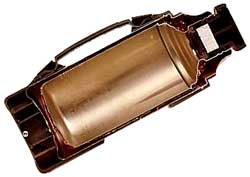DK Science & Technology: Heat
Everything around us contains heat. Heat is a form of energy—the energy of the random jiggling motion of particles that make up all matter. TEMPERATURE is a measure of how hot an object is—it can be recorded on a THERMOMETER.
Heat always flows from a higher temperature to a lower temperature. If you stand next to a hot oven, the heat from it warms you up. Different materials let heat flow through them at different rates. Metals are the best conductors (they let heat flow easily). THERMAL INSULATORS don’t conduct heat well.
Conduction is the transfer of heat from one molecule to another. Energetic molecules pass on heat energy when they collide with less energetic molecules. Convection is the transfer of heat through a liquid or a gas as warm fluid rises and cool fluid sinks. These movements are convection currents. Radiation is the movement of heat by electromagnetic rays. All objects emit radiation, but the hotter they are, the more radiation they give off.
We cannot see heat, but we can see its effects. Convection currents rising from a hot asphalt road make the air above shimmer. A thermal-imaging camera detects radiation emitted by hot objects. Electronics convert invisible electromagnetic rays into an image on a television screen.
Temperature tells us how hot an object is. It is a measure of how fast the particles in the object are moving. The hotter an object, the more vigorously its molecules move. Temperature is measured in degrees on a temperature scale.
If you could remove all the heat energy from an object, its molecules would be effectively stationary. The temperature at which molecules are no longer moving is called absolute zero. It is the lowest possible temperature. Absolute zero is equivalent to –459.67°F (–273.15°C).
The instrument for measuring temperature is called a thermometer. Most thermometers have a scale with two fixed points—the melting point of ice and the boiling point of water. All temperatures are measured against these points.
Thermostats control the temperatures of buildings and machines. A simple room thermostat has a two-metal strip as part of a switch that turns the heat on and off. As the temperature rises, the two metals in the strip expand by different amounts. The strip bends, breaking the circuit and turning off the heat supply. As the room cools, the strip straightens, completes the circuit again, and turns the heat back on.
Any material that resists the flow of heat is a thermal insulator. Many animals keep warm because fur is a good insulator—it stops heat from flowing away from their bodies.
A vacuum bottle (Thermos™) is designed to keep hot food hot, or cold food cold. Double walls prevent heat flow in or out by conduction. The walls are silver-coated to reflect electromagnetic rays, reducing heat transfer by radiation. The space between the walls contains air at a low pressure (vacuum). This reduces heat transfer by convection.

